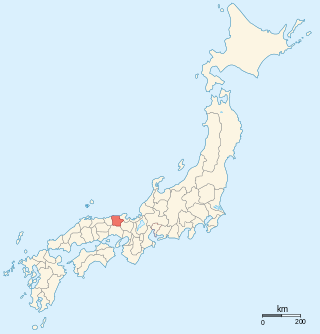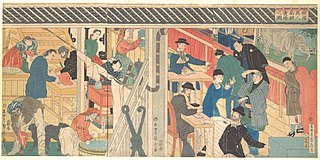Related Research Articles

Utagawa Kunisada, also known as Utagawa Toyokuni III, was a Japanese ukiyo-e artist. He is considered the most popular, prolific and commercially successful designer of ukiyo-e woodblock prints in 19th-century Japan. In his own time, his reputation far exceeded that of his contemporaries, Hokusai, Hiroshige and Kuniyoshi.

Utagawa Toyokuni, also often referred to as Toyokuni I, to distinguish him from the members of his school who took over his gō (art-name) after he died, was a great master of ukiyo-e, known in particular for his kabuki actor prints. He was the second head of the renowned Utagawa school of Japanese woodblock artists, and was the artist who elevated it to the position of great fame and power it occupied for the rest of the nineteenth century.

An art name, also known by its native names hào, gō, ho, and tên hiệu, is a professional name used by East Asian artists, poets and writers. The word and the concept originated in China, where it was used as nicknames for the educated, then became popular in other East Asian countries.

The Utagawa school (歌川派) was one of the main schools of ukiyo-e, founded by Utagawa Toyoharu. It was the largest ukiyo-e school of its period. The main styles were bijin-ga and uki-e. His pupil, Toyokuni I, took over after Toyoharu's death and led the group to become the most famous and powerful woodblock print school for the remainder of the 19th century.

Utagawa Kunisada II was a Japanese ukiyo-e print designer, one of three to take the name "Utagawa Kunisada". He headed the Utagawa school.

Utagawa Toyohiro, birth name Okajima Tōjiro (1773–1828), was a Japanese ukiyo-e artist and painter. He was a member of the Utagawa school and studied under Utagawa Toyoharu, the school's founder. His works include a number of ukiyo-e landscape series, as well as many depictions of the daily activities in the Yoshiwara entertainment quarter; many of his stylistic features paved the way for Hokusai and Hiroshige, as well as producing an important series of ukiyo-e triptychs in collaboration with Toyokuni, and numerous book and e-hon illustrations, which occupied him in his later years.

Utagawa Kunisada III (歌川国貞) (1848–1920) was an ukiyo-e printmaker of the Utagawa school, specializing in yakusha-e. He began studying under Utagawa Kunisada I at the age of 10, and continued under Kunisada II after their master's death.
The name Utagawa may refer to:
Toyokuni may refer to:

Utagawa Toyokuni II (1777–1835), also known as Toyoshige, was a designer of ukiyo-e Japanese woodblock prints in Edo. He was the pupil, son-in-law and adopted son of Toyokuni I. The former used the name Toyoshige (豊重) until 1826, the year after his teacher's death, when the family gave him the right to use his teacher's name and he began signing his work Toyokuni (豊国). In 1835 he died, and in 1844 the family persuaded Kunisada, the most famous student of Toyokuni I, to use the name "Toyokuni" and become leader of the school. Although Kunisada never recognised Toyoshige's right to the name Toyokuni, nevertheless Kunisada after 1844 is always referred to as Toyokuni III.
Ukiyo-e artists may be organized into schools, which consist of a founding artist and those artists who were taught by or strongly influenced by him. Artists of the Osaka school are united both stylistically and geographically. Not all of these artists designed woodblock prints, and some ukiyo-e artists had more than one teacher, and others are not known to be associated with any particular school.

Utagawa Kunimasu was a designer of ukiyo-e woodblock prints in Osaka who was active during the late Edo period. He was a leading producer of kamigata-e, prints from the Osaka and Kyoto areas. He is also known as Sadamasu [貞升], the artist name he used prior to Kunimasu.

Utagawa Toyoharu was a Japanese artist in the ukiyo-e genre, known as the founder of the Utagawa school and for his uki-e pictures that incorporated Western-style geometrical perspective to create a sense of depth.

Female Ghost is an ukiyo-e woodblock print dating to 1852 by celebrated Edo period artist Utagawa Kunisada, also known as Toyokuni III. Female Ghost exemplifies the nineteenth century Japanese vogue for the supernatural and superstitious in the literary and visual arts. The print is part of the permanent collection of the Royal Ontario Museum, Toronto, Canada.

Fan print with two bugaku dancers is an ukiyo-e woodblock print dating to sometime between the mid 1820s and 1844 by celebrated Edo period artist Utagawa Kunisada, also known as Toyokuni III. This print is simultaneously an example of the uchiwa-e and aizuri-e genres. It is part of the permanent collection of the Royal Ontario Museum, Toronto, Canada.

Bust portrait of Actor Kataoka Ichizō I is an ukiyo-e woodblock print belonging to the permanent collection of the Royal Ontario Museum, Canada. The print dates to around the mid nineteenth century, and is an example of kamigata-e, prints produced in the Osaka and Kyoto areas. The ROM attributes the print to Utagawa Sadamasu II, but other institutions identify Utagawa Kunimasu—also known as Sadamasu I—as the artist.

Actor Ichikawa Ebijūrō as Samurai is an ukiyo-e Japanese woodblock print by Osaka-based late Edo period print designer Shunshosai Hokuchō. The print depicts a scene from a kabuki play featuring Osaka actor Ichikawa Ebijūrō (市川蝦十郎) in the role of a samurai. One impression of the print belongs to the permanent collection of the Prince Takamado Gallery of Japanese Art in the Royal Ontario Museum, Canada.

Utagawa Sadahide, also known as Gountei Sadahide, was a Japanese artist best known for his prints in the ukiyo-e style as a member of the Utagawa school. His prints covered a wide variety of genres; amongst his best known are his Yokohama-e pictures of foreigners in Yokohama in the 1860s, a period when he was a best-selling artist. He was a member of the Tokugawa shogunate's delegation to the International Exposition of 1867 in Paris.

Kabukidō Enkyō was a Japanese artist who designed ukiyo-e woodblock prints. Nothing is known of Enkyō's life, and only seven of his works are known, all of which are ōkubi yakusha-e, bust portrait prints of kabuki actors. Scholars divide them into two groups based on differences in the signatures, and the second group appears to be a set, as the prints depict three brothers from the same play. Enkyō's identity has been subject to speculation: a student of Sharaku's, even Sharaku himself, or a kyōgen playwright.
References
- Richard Lane: Images from the Floating World. Fribourg, 1978, ISBN 0-88168-889-4
- Amy Reigle Newland (Hrsg.): The Hotei Encyclopedia of Japanese Woodblock Prints. 2 vol., Amsterdam, 2005, ISBN 90-74822-65-7
- Laurance P. Roberts: A Dictionary of Japanese Artists, Weatherhill, Tokyo and New York, 1976 and 1990, ISBN 0-8348-0235-X
- Friedrich B. Schwan: Handbuch Japanischer Holzschnitt. Hintergründe, Techniken, Themen und Motive. Iudicium, München 2003, ISBN 3-89129-749-1 (German)

